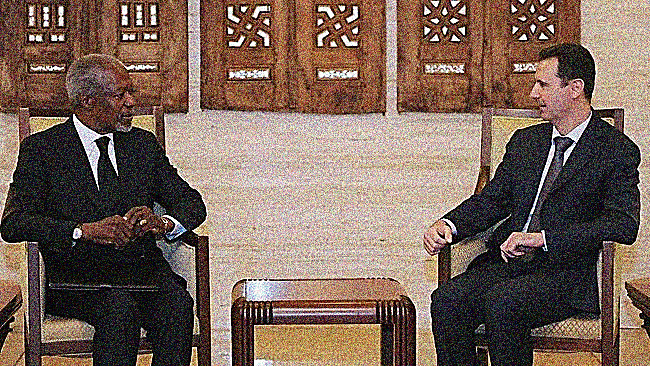Annan and Assad.
UN-Arab League Envoy Kofi Annan’s peace plan for Syria has not failed. No, Syrian troops and heavy weapons have not been withdrawn from cities as called for, but as of April 12 in Syria, there have been no reports of significant government attacks. For at least the time being, a ceasefire seems to be in place. Of course, President Assad in a letter said he reserved the right to respond to “terrorist” attacks and large protests expected tomorrow will put him to the test. In all likelihood, the plan as set out by Annan will not be realized, but any failure will not be his, but that of Assad.
For all the criticism of Annan and his plan in recent days, his efforts have made unified action by the international community, led by the UN Security Council, more likely. No longer can Russia and China, the countries that have blocked past efforts at strong resolutions and action, hide behind the argument that strong diplomatic efforts have not been exhausted. The next step should be what Bruce Jones of the Brookings Institution calls “diplomatic overtime”. UN monitors should be rushed in as soon as possible. Perhaps the plan can be salvaged or the halt in killing be extended.
If as has happened in the past, the Assad regime fails to live up to its promises the next step should be a strong, unanimous UN Security Council resolution that clearly condemns Assad, implements an arms embargo, refers the leaders of the Syrian regime to the International Criminal Court and sets a clear deadline before, as they say in UN-speak, “all necessary measures” are taken to protect civilians in Syria. This is the spirit of the Responsibility to Protect — a graduated escalation of options before force may be used as a last resort.
Now is not the time for force. The likelihood of even more bloodshed and deaths of civilians is too great, the disunity of the opposition groups too strong and the will of the international community too weak. It is not possible to establish “safe zones” without boots on the ground, air strikes and a willingness or at least preparedness to escalate. But the time for such intervention may be nearing and the will of the international community to carry it out is growing with each olive branch that Assad chooses to crush, not to mention each civilian life that is taken (over 1,000 Syrians have been reportedly killed since Assad said he accepted Annan’s peace plan).
The international community should continue to support Annan’s plan and use the next days to pursue “diplomatic overtime” but it should also prepare for the next steps that may need to be taken. If an intervention is to take place to protect civilians it should be multilateral (see Bruce Jones’ suggestion for a stabilization force in Foreign Policy) and come with the endorsement of the UN Security Council. That will be largely up to Russia and China. However, the lead of regional powers can make a difference. Qatar and Saudi Arabia are already arming the opposition. Turkey has warned that further attacks across its border (two people were killed in a Turkish refugee camp when Syrian forces opened fire across the Turkish border) could lead it to invoke NATO help protect its borders.
For now Annan’s plan is the least worst option in a sea of bad to horrible ones. It may very well fail to be implemented as designed but it has already succeeded in pausing the most intense period of fighting since the crackdown began 13 months ago. Moving forward, Annan’s plan will not be a failure if this latest legitimate effort at peace unifies the UN Security Council for real pressure on Syria, mobilizes regional support for further action and demonstrates to the world that this is not about an interventionist western policy but about a regime thumbing its nose at the world, even as civilians continue to die in large numbers.
Daniel P. Sullivan is the Director of Policy and Government Relations for United to End Genocide.

